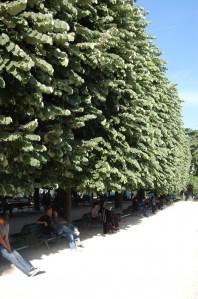Position: Flourishes in full sun to partial shade.
Soil: Moist but well drained.
Flowering period: Early summer.
Eventual Height: 30m
Eventual Spread: 20m
Hardiness: USDA Zone 4b-10a
Family: Malvaceae
Tilia tomentosa is a deciduous tree with a broadly columnar habit. It has rounder to broadly ovate, occasionally lobed dark green leaves that are densely white-hairy underneath. In early summer it bears cymes of up to ten very fragrant white flowers. Following the flowers a 8-10mm long drupe is produced.
T. tomentosa is commonly known as the Silver Lime in the UK and Silver Linden in the US is native to southwestern Asia. An infusion of flowers of this tree used by herbalists which is believed to be antispasmodic, diaphoretic and sedative..
Tilia is the ancient Latin name for the Lime Tree, with tomentosa being derived from Latin meaning ‘densely hairy’.

Tilia tomentosa pleached (14/05/2011, Paris)
The landscape architect will find this useful in urban situations due to it tolerance of pollution, soil compaction, drought and heat. This tree is also suitable for pleaching. The cultivar of this tree T. “Brabant’ is also useful as it has a symmetrical conical crown.
This plant prefers an alkaline soil composed of sand, clay, loam or chalk. It will also prefer a sheltered location facing any aspect.
Ecologically the plant is pollinated by honeybees, however it is toxic to other bees that cannot digest its nectar, shown by large numbers of comatose bees below the tree while it is in inflorescence.
The Royal Horticultural Society have given the cultivar T. japonica ‘Petiolaris’ their prestigious Award of Garden Merit.
Maintenance: The removal of dead or damaged material and pruning should be carried out from mid-summer to mid-winter to prevent the wound from bleeding too much. This plant can also withstand a very hard pruning.


